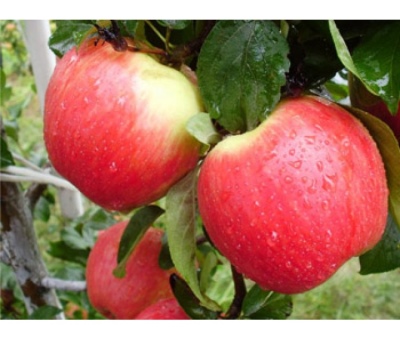
- Authors: Germany
- Taste: sweet and sour
- Scent: caramel
- Fruit weight, g: 140-150
- Ripening terms: summer
- Removable maturity: second half of August
- Keeping quality: up to 3 weeks
- Transportability: Yes
- Self-fertility: self-infertile, Golden Delicious, Elstar, Pirelli
- Early maturity: early
An early variety of apples is always in demand among gardeners, but such varieties always have a small drawback - a short shelf life. But there are also early-ripening apple trees with a longer shelf life after harvest. For example, the German apple variety Piros. In this article, we will consider its features, advantages and disadvantages, taste, agrotechnical aspects and preparation for winter.
Breeding history of the variety
In 1963, a new hybrid Piros was bred at the German Horticultural Institute Dresden-Pilnitz. The parental pair are apple varieties Helios and Apollo. The hybrid gained its popularity in Germany only in 1985.
Description of the variety
The apple tree Piros belongs to an early-maturing variety and is considered a semi-clik tree. The height of the tree is 4-4.5 m, in the early years the trunk is characterized by rapid growth, later this process will slow down.
The crown of the tree is round, compact, semi-spreading, but not thickened. Leaves are medium-sized, saturated green shade with a pronounced section on the back surface.
Apple tree Piros begins to bear fruit for 3 years after planting in the ground. Gardeners note that the hybrid is not prone to periodic fruiting.
Features, pros and cons
Any culture has its own characteristics, which consist in positive and negative aspects.
Consider the positive aspects of a hybrid:
early maturity;
ripening of fruits;
taste qualities;
bountiful and annual harvest;
shelf life;
excellent transportation performance;
appearance.
The disadvantages include the fact that the variety is not resistant, that is, the hybrid is exposed to some diseases and pest attacks.
Ripening and fruiting
Flowering begins in May, and the first crop can be harvested in August in the southern regions; in the northern regions, the crop is harvested in the first weeks of September. Harvesting takes place in several stages.
Yield
Growers report high and stable yields. And also an active period of fruiting in the Piros apple tree from 5 to 25 years.
Fruits and their taste
The fruits are large, weighing 140-150 g, round and cylindrical in shape. Apples grow to about the same size. The fruits are well attached to the stalk and do not crumble.
The skin is dense, does not burst, which contributes to good transportation. In shade, it is pale yellow with an inherent crimson blush on the sides (those sides that have been in the sun longer).
The pulp is juicy, dense, with a high content of juice. By taste, the fruit is sweet-sour, with a pronounced caramel aftertaste.
Fruits are stored in a cool place at a temperature not higher than +5 degrees for up to 3-4 weeks.

Growing features
The Piros apple tree does not require special agrotechnical requirements.All that needs to be observed is regular watering, fertilizing, pruning branches - forming a crown, preventive work against pests and preparing for winter, mulching the soil.
The choice of location also affects the yield, so it is necessary to properly prepare the site. The crown of the tree, although compact, is still spreading, so the site must be free for the culture to grow conveniently. If there are other types of crops nearby, then the distance between them must be kept from 3 m. This is necessary so that the branches do not touch and do not interfere with each other.
And also the place should be sunny. It is best to plant the seedling on a small hillock to avoid groundwater. If this is not possible, then drainage is installed when landing in the hole.
It is worth loosening the area around the trunk 1-2 times every two weeks to saturate the soil with oxygen. Apple tree Pierce loves loose, loamy soil.



Pollination
The Pyros hybrid has good and large flower stalks, but they are completely sterile, therefore, in order for the harvest to be large and good, it is necessary to plant pollinating apple trees nearby. These can be varieties of apple trees Vista, Pirelli, Golden Delicious.
Top dressing
Top dressing of apple trees is carried out in several stages. In the spring, it is necessary to feed the plant with natural minerals and those that contain nitrogen. In the summer they feed the apple tree with natural minerals, and in the fall with minerals containing fluorine. All fertilizers are applied to the trunk circle.

Frost resistance
Preparing for winter is important and should never be ignored. Preparation begins two weeks after harvest, or when more leaves fall.
First, the tree is examined at the time of damage, pests or diseases. Then, preventive measures are taken to remove dry branches or places where the bark has exfoliated. All sections are processed with garden varnish, and the trunk itself is whitewashed.
Then, in regions with severe frosts or with sudden temperature changes, it is worth covering the trunk. To do this, it is necessary to drive several pegs around the apple tree trunk, at a distance of 20 cm and wrap the pegs with agrofibre or roofing material. You can fix it with wire. But in the formed space between the pegs and the trunk, you can fill it with mulch or peat.


The apple tree is a popular fruit crop among gardeners.It can be found in many summer cottages. But at the same time, such trees are often affected by various diseases. It is very important to recognize the disease in time and carry out the necessary procedures for a speedy recovery. Otherwise, the fruits will be spoiled, and the tree itself may die altogether.












































































